“Predicting the future isn’t magic, it’s a strategic imperative for business.”
Have you ever wondered what the future of your business looks like? Well, you are not alone.
Instead, it is common practice for businesses to predict their future sales performance, i.e., sales forecast.
This acts as a beacon guiding businesses in the world on uncertainty. It helps them to make informed decisions.
But how do you forecast sales?
Well, in this blog, we will discuss everything, starting from basics like what is a sales forecast to how you create one.
We will even discuss some best tools in the market that can make your job easier.
What is a Sales Forecast?
A sales forecast is a prediction or estimation of future sales performance.
It is an in-depth report that predicts the future sales of the company at a given time, for instance, annually, monthly, or quarterly.
And how does it work? A sales forecast report is created by analyzing historical sales data market trends and various internal and external factors to make reliable predictions.
Businesses often rely on sales forecasts to anticipate future revenue, allocate resources, set clear targets, and make informed decisions.
Why is sales forecasting so important?

Sales forecasting is critical for businesses as it offers a road map for future success and sustainability.
Let’s discuss in detail why sales forecasting is so indispensable for businesses across various facets:
Resource allocation
By predicting future sales, one can allocate resources effectively. It helps businesses to prevent over or understocking of inventory.
It also optimizes marketing expenditure and maximizes ROI.
Financial planning
Sales forecasting provides a solid foundation for financial planning for the upcoming year.
It helps businesses to anticipate their revenue stream, forecast cash flow, and set realistic financial targets.
Strategic decisions
Another benefit of sales forecasting is that it helps in making informed decisions in product development, market expansion, resource allocation, and more.
Performance evaluation
Sales forecast also serves as a benchmark for a business to evaluate its performance.
They can compare the actual sales to the forecasted level to determine the effectiveness of their business strategies.
Risk management
Accurate sales forecasts enable businesses to predict future risks and mitigate fluctuations.
By understanding potential revenue streams, businesses can adapt their strategies and minimize the impact of external factors on their business operation.
Overall, sales forecasting is essential for growth, making informed decisions, optimizing performance, and ensuring long-term success.
What factors impact a sales forecast?
Several factors play a vital role in predicting future sales performance.
Let’s discuss them one by one:
Historic Data and Reports
As mentioned, analyzing historical sales data allows businesses to identify certain trends and patterns in their sales performance.
By studying past sales figures, companies can identify various factors that influence their sales, such as changes in consumer behaviors, economic conditions, and even competitor actions.
In this way, businesses can forecast future sales more accurately.
Analyzing historical data also helps in making informed decisions about future strategies, investments, and resource allocation for maximum sales and profit.
As they say, studying history allows us to learn from the mistakes and successes of the past.
It provides valuable insights to make informed decisions in the future.
Sales Process
The sales process refers to a series of steps that help the sales team identify & engage potential customers.
It guides them through their buying journey and ultimately converts them into paying customers.
This process includes lead generation, lead qualification, and conversion.
Let’s understand these steps in detail:
- Lead generation
This stage involves identifying and attracting potential customers.
These steps include various processes like marketing campaigns, advertising, networking, and even referrals.
A successful lead generation strategy results in a large pool of potential customers.
- Lead qualification
Once leads are generated, they need to be evaluated according to their likelihood of making a purchase.
This process involves assessing factors like the prospect’s needs, budget, and authority to make a purchase.
- Conversion
Finally, conversion refers to the process of turning qualities into paying customers.
Understanding this sales pipeline is important to forecast accurate sales data.
This helps sales teams assess the health of their sales efforts and the average time taken to convert a lead into paying customers.
It also helps to understand how many leads are on each stage of the pipeline and their likelihood of conversion.
CRM
CRM systems facilitate accurate sales forecasting for businesses by consolidating and organizing historical customer data.
It provides a solid foundation to predict the future sales opportunities.
It also enables you to analyze past performance, and customer interactions through various touch points and market trends to generate precise forecast reports.
Additionally, a good CRM tool also empowers sales teams with real-time insights into the sale pipeline’s conversion rates and lead quality.
It allows them to make proactive adjustments and optimization to maximize the sales potential.
Set goals
Setting clear and achievable sales goals is important for effective sales forecasting. Why?
Because these goals serve as benchmarks against which you can evaluate your performance and sales efforts.
And they also ensure that it aligns with your broad business objectives.
By specifying targets, such as revenue targets or sales quotas you can get a clear direction for your sales team and create a framework for success.
Review previous forecasts
By regularly reviewing and evaluating your past sales forecast, you can increase the accuracy of the future sales forecast.
Try to analyze the historical data and compare forecasted figures with actual sales results.
This will help you to identify the trends, patterns, and discrepancies that will guide you in your future casting strategies.
It also helps to understand the factors influencing your sales performance such as market conditions, customer behavior, and sales tactics.
Right forecasting method
Choosing the right forecasting method is important for generating reliable and accurate sales forecasts.
Different forecasting methods are qualitative, quantitative, or mixed methods.
Each of these has its unique advantages and is suitable for different scenarios.
These are some factors that can affect your sales forecast.
Now let’s let’s move on to the main question – how to create a sales forecast and that too effective one.
How to create an effective sales forecast?
Creating a sales forecast can be difficult for you if you are new to it.
Let’s break down the whole process into simple steps and understand them one by one.
Define Your Offering
The first step is defining the product and services you are selling.
Make a note of everything including its unique features, benefits, and target market.
When you know your offering better, you can accurately predict sales. Why? Because it provides you insights into the value proposition and appeals to potential customers.
By understanding what sets your offering apart from the competitors and how well it resonates with the target audience you can forecast demand and anticipate sales accurately.
Estimate Sales Quantity
The next step involves estimating the number of products and services you expect to sell within a specific timeframe.
To do this, you will have to refer to market research, historical data, and sales projections.
You will also need to consider the market demand, competition, seasonality, and any other external factors that may impact your sales.
Set Unit Price and Total Income
Now determine the price at which you will sell each unit of your product or service.
Consider factors like production cost, market demands, competitor pricing, etc.
Multiply the estimated sales quantity with the price to calculate your total revenue.
Calculate Production Costs
As we already mentioned, you need to consider the production cost to calculate the expected total revenue.
Identify and calculate the cost that is associated with producing a delivery of your product or service. You have to include materials, labor, overhead, and other expenses.
To calculate your gross profit, you need to subtract the production cost from your total income.
Calculate Total Revenue
Finally to calculate your total revenue consider factors like recurring sales, upsells, and add-ons.
By calculating all revenue sources, you can create a comprehensive sales forecast that will reflect the true revenue potential of your business.
Follow these steps to create an effective sales forecast report for your organization.
Common sales forecasting challenges
While creating your sales forecast reports, you will likely encounter various challenges. And as it is said, “understanding the challenge ahead is the first step towards overcoming them”.
So let’s try to understand these challenges to solve them effectively.
Limited historical data
When a business has just introduced a new product, it cannot predict future performance accurately. Why? Because there is a lack of historical sales data.
To overcome this challenge, you can rely on market research, industry benchmarks, and customer feedback. This will help them to make informed estimates.
Seasonal variations
Seasonal fluctuations in demand can also impact the sales forecast leading to inaccuracies.
For businesses that are affected by seasonality, it is important to adjust the forecast based on the historical sales pattern, industry trends, and as well as seasonal factors.
By analyzing past sales data during different seasons, a business can develop accurate forecasts and allocate resources effectively to meet fluctuating demands.
Changing market conditions
Market conditions such as shifts in consumer preferences, economic downturns, or new competitors can disrupt the sales forecast.
To resolve this issue a business has to stay informed about the latest market trends and adapt their forecast accordingly.
By regularly monitoring competitor activities, conducting regular market research, and adjusting sales strategies, one can remain in competition and meet changing customer needs.
Sales cycle length
A sales cycle determines how long your customer takes to buy a product or service.
This time can differ based on factors like how complicated the product is, how long it takes for the customer to make a decision, and even the competition in the market.
You can mitigate this challenge by keeping an eye on how leads are moving through the sales process and measuring how many of them are converting into buying customers.
By understanding the actual sales cycle length, you can adjust the focus and predict accurate future sales.
Forecast accuracy
Even with all the meticulous planning and analysis, achieving accurate cells for cast can be challenging.
There will be unforeseen factors and uncertainties that will impact the actual sales performance.
To remove such errors and improve the forecast accuracy a business should continuously monitor their actual sales performance against forecasted figures.
This allows them to identify discrepancies and refine the forecasting methods and assumptions early.
These were some challenges you have to look for while making a sales forecast report to create accurate data and mitigate any errors.
Best tools for sales forecasting
Now that we know that sales forecasting is crucial for businesses, let’s find some best tools that can help to make your job easy.
These tools assist you in generating reliable and accurate reports.
Zoho
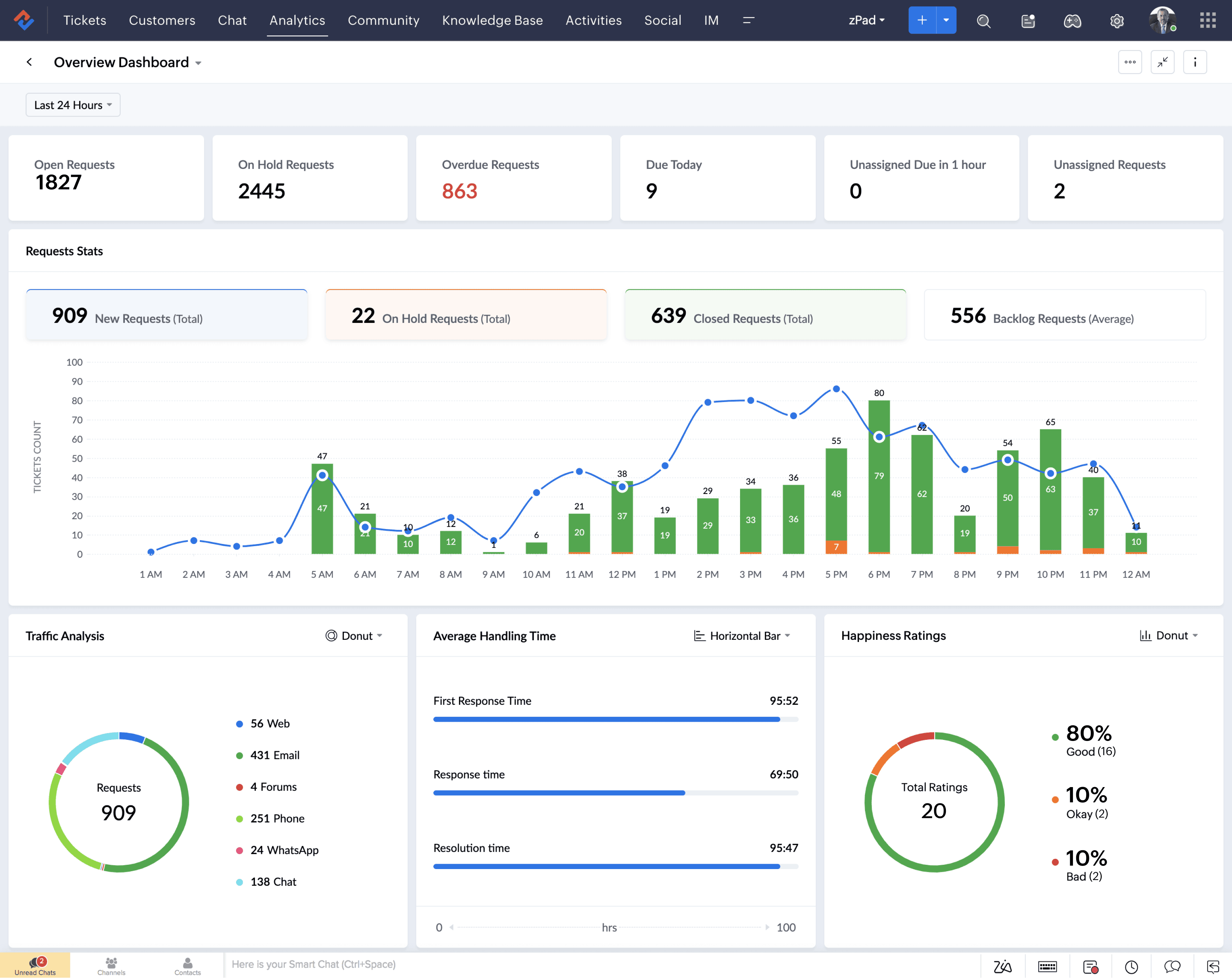
Zoho CRM is a comprehensive customer relationship management platform.
It offers advanced features for managing customer relationships, sales pipelines, and marketing campaigns.
Pros
- Versatile conditional forecasts tailored to your business needs.
- Flexible forecasting system adaptable to your sales process.
- Segmentation of pipeline deals into best-case and committed categories.
- Enhanced forecast accuracy through template-based forecasting.
- Access to Zoho’s AI, Zia, for predictive forecasting and target recommendations.
- Tracking and refinement of forecasts facilitated by transparent pipeline data.
Cons
- Versatile conditional forecasts tailored to your business needs.
- Flexible forecasting system adaptable to your sales process.
- Segmentation of pipeline deals into best-case and committed categories.
- Enhanced forecast accuracy through template-based forecasting.
- Access to Zoho’s AI, Zia, for predictive forecasting and target recommendations.
- Tracking and refinement of forecasts facilitated by transparent pipeline data.
Pricing
Zoho CRM offers four pricing plans for its customers:
- Standard: $20 per month
- Professional: $35 per month
- Enterprise: $50 per month
- Ultimate: $65 per month
Putler
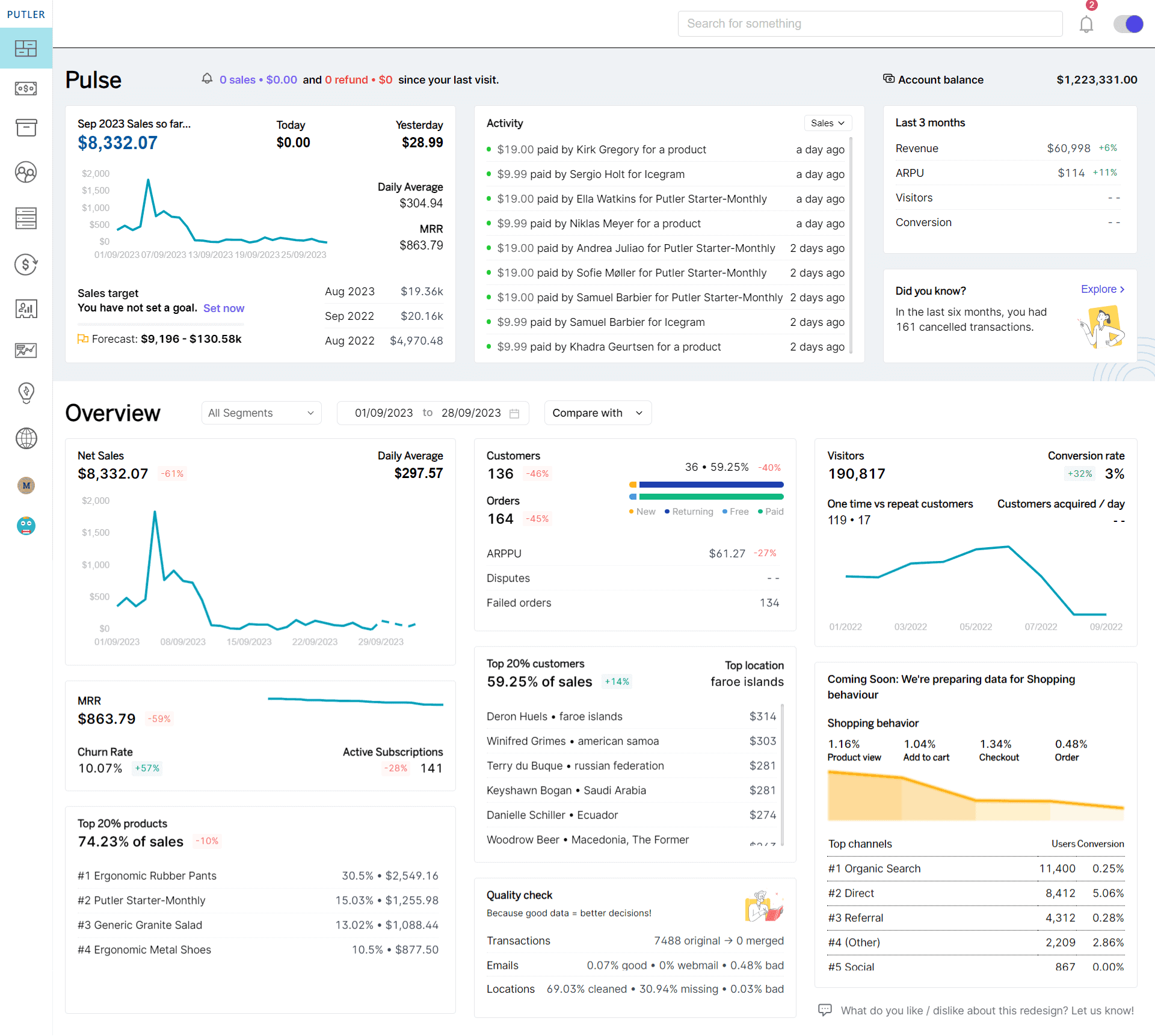
Putler is an analytics and reporting tool for eCommerce and SaaS businesses.
It comes with advanced sales forecasting.
First, on the home dashboard, you can get an overview of your past sales trends and future predictions.
Secondly, you can dive into detail using the dedicated sales forecasting dashboard “Time Machine”.
It processes your data and creates forecasts of future sales. This includes monthly revenue from customers and 10x growth.
You can use this data to create your forecast report.
You can even make changes to the various parameters to align the data with your business goal.
Pros
- Automated forecasting leveraging historical data
- Improved planning with precise future revenue and customer growth insights
- Ambitious goal-setting to motivate the team
- Flexibility to adapt to users’ needs and goals
- Dedicated sales dashboard to provide accurate data on net sales, daily average, order, and average revenue
- Sales heatmap indicating sales activity in your sale
Cons
- Time Machine is built on linear progression and hence does not take seasonal trends into account.
Pricing
Putler offers three different plans for you.
- Starter: $20 per month
- Growth: $50 per month onwards
- Custom: You can get a tailored plan to accommodate all your needs
EngageBay
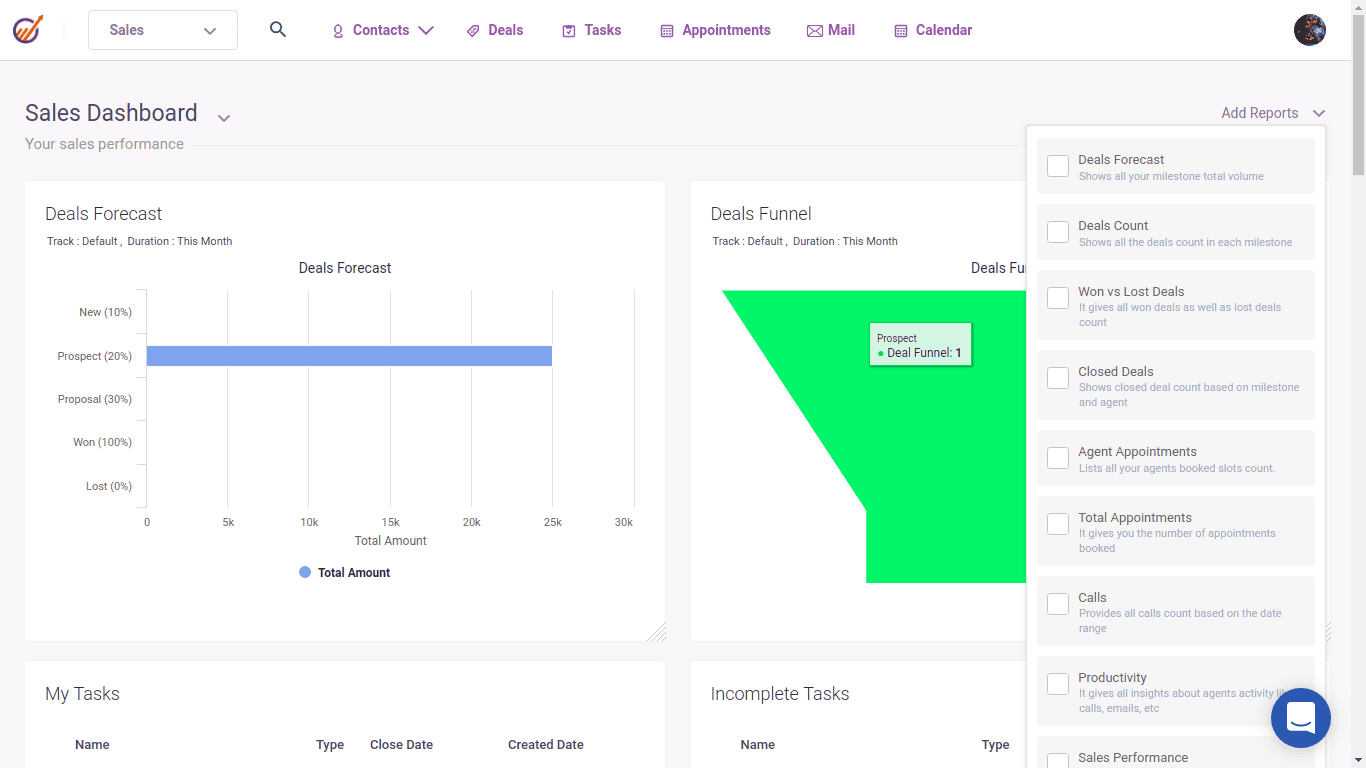
EngageBay is yet another smart solution for all your activities.
It has four products, among which CRM & sales bay is packed with features to help you predict accurate sales forecast reports.
Pros
- Holistic customer profiles for rich insights into your audience.
- Track sales performance and trends.
- Track and filter out the most qualified leads to close more deals.
- Lead confidence feature to accurately estimate your sales in a quarter.
- On-demand reports for up-to-date sales forecasting data.
- Sales gamification to boost friendly competition amongst sales reps for more lead conversion.
Cons
- Limited customization options for sales forecasting
- Insufficient to meet the growing needs of businesses
Pricing
EngageBay has four pricing plans:
- Free plan
- Basic plan: $12.99 per month
- Growth plan: $24.99 per month
- Pro plan: $49.99 per month
How can Putler support your sales forecasting efforts?
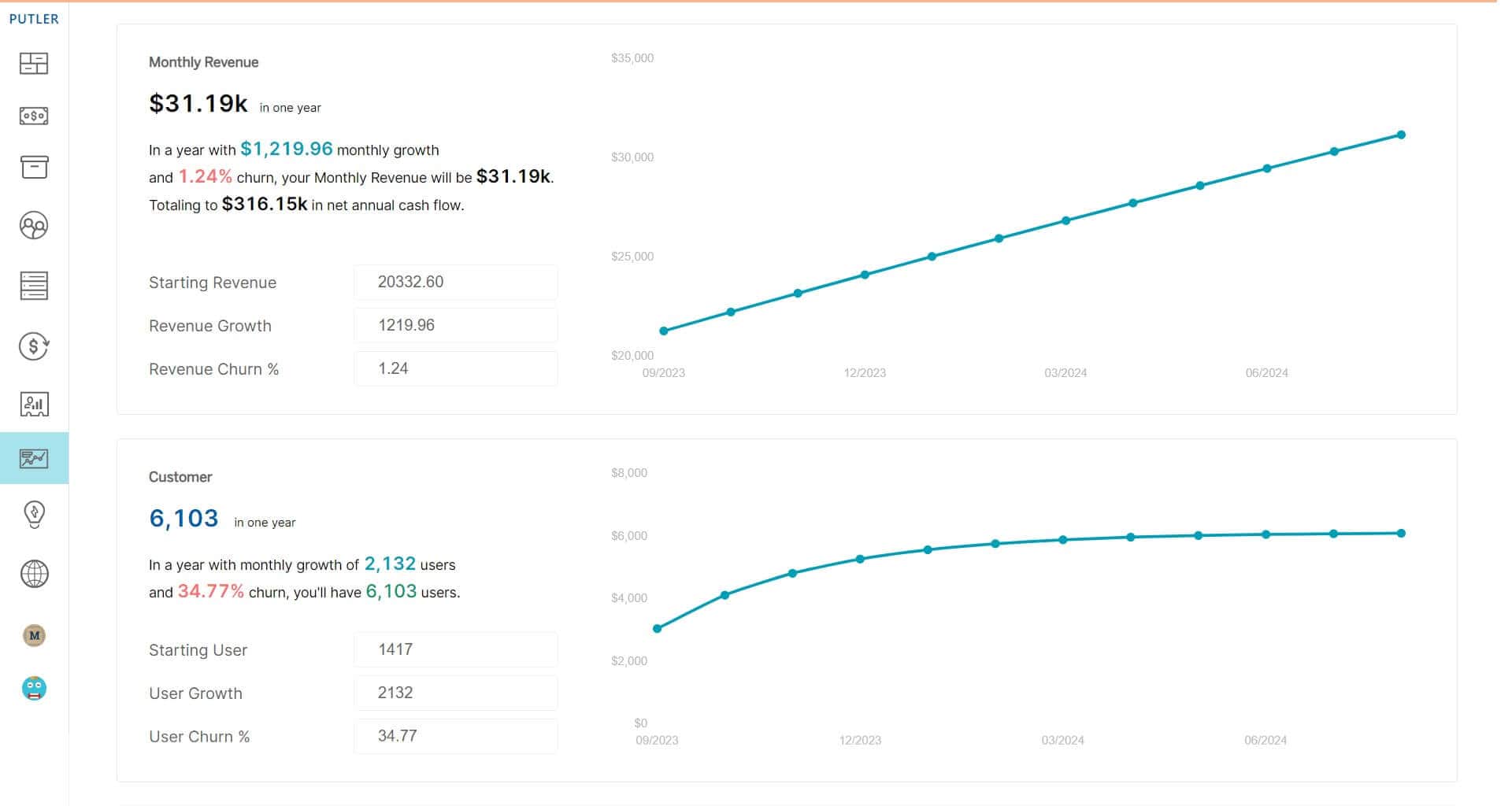
Putler’s sales forecasting dashboard, known as the Time Machine, offers robust support for your sales forecasting endeavors.
Upon importing your data into Putler, the Time Machine springs into action and starts the magic to process your information.
It generates a forecast of three aspects:
- Monthly Revenue
- Customers
- 10x growth
Revenue forecast
Based on your revenue in a said month, Putler predicts monthly revenue for the whole year.
On the dashboard, you will see three metrics, starting revenge, revenue growth, and revenue churn.
Starting revenue represents your average review of the previous 90 days.
Revenue growth is the % difference in revenue for the last three months’ gross sales and its corresponding previous three months’ gross sales multiplied by the last three months’ gross sales.
Lastly, revenue churn represents the revenue lost.
This helps business owners protect the cash flow in their organization and make critical decisions accordingly.
Customer forecast
Another interesting feature of the Time Machine is that it allows you to understand how many customers you will have by the end of this year.
Based on the number of customers you have for a specific month, Putler customer account at the end of 12 months.
It considered your user growth and the number of customers that returned every month.
10x forecast
Lastly, the 10x forecast is a special feature of Putler.
The Time Machine inputs the current status of your business and your target and then forecasts 10x the growth of your business.
And how does this work?
Well, Putler shows you a way to achieve 10x growth. It tells you how much you can grow if you have 3x traffic, 2x conversion rate, and 2x ARPU.
The numbers that you get from 10x help you to set a realistic business goal and plan your marketing efforts & outreach efforts accordingly.
Monthly Sales Forecast
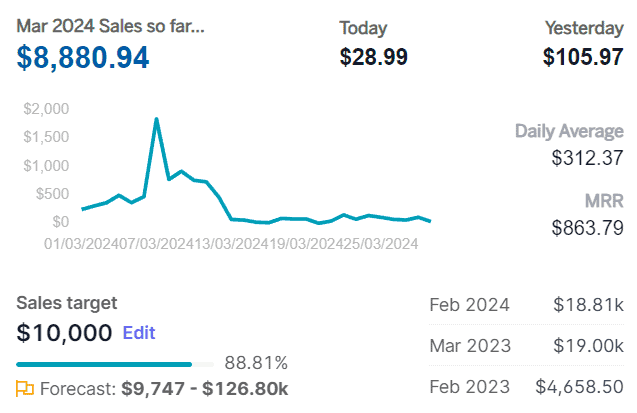
If you want a glimpse of how your sales are performing and how it will go in the near future, you can access the monthly sales forecast feature, present on the home dashboard.
It presents the numbers in visual form so that you can gauge the sales trend and predictions with a glance.
By using this feature, you can keep an eye on your monthly progress and adjust your annual forecast in case of any disparities.
Conclusion
Sale forecasting is not merely a numerical exercise. It is a strategic tool that can help you to navigate through uncertainties and make better decisions.
It can help you to capitalize on opportunities, mitigate risks, and grow your revenue.
Although nobody can predict the future, make sure your forecasts are the closest to accuracy. This solidifies that you can rely on the report for decisions. Think of it as GPS. If it’s not accurate you can get lost.
And that’s why, you need to use tools like Putler to automate the forecasting process and make your reports more reliable.
